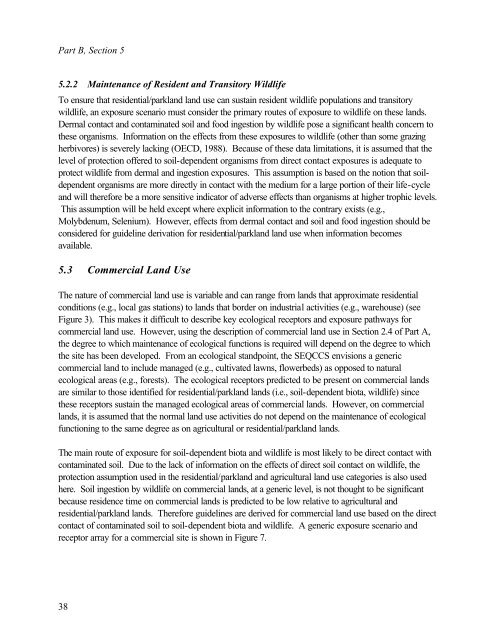Protocol for the Derivation of Environmental and Human ... - CCME
Protocol for the Derivation of Environmental and Human ... - CCME
Protocol for the Derivation of Environmental and Human ... - CCME
You also want an ePaper? Increase the reach of your titles
YUMPU automatically turns print PDFs into web optimized ePapers that Google loves.
Part B, Section 5<br />
5.2.2 Maintenance <strong>of</strong> Resident <strong>and</strong> Transitory Wildlife<br />
To ensure that residential/parkl<strong>and</strong> l<strong>and</strong> use can sustain resident wildlife populations <strong>and</strong> transitory<br />
wildlife, an exposure scenario must consider <strong>the</strong> primary routes <strong>of</strong> exposure to wildlife on <strong>the</strong>se l<strong>and</strong>s.<br />
Dermal contact <strong>and</strong> contaminated soil <strong>and</strong> food ingestion by wildlife pose a significant health concern to<br />
<strong>the</strong>se organisms. In<strong>for</strong>mation on <strong>the</strong> effects from <strong>the</strong>se exposures to wildlife (o<strong>the</strong>r than some grazing<br />
herbivores) is severely lacking (OECD, 1988). Because <strong>of</strong> <strong>the</strong>se data limitations, it is assumed that <strong>the</strong><br />
level <strong>of</strong> protection <strong>of</strong>fered to soil-dependent organisms from direct contact exposures is adequate to<br />
protect wildlife from dermal <strong>and</strong> ingestion exposures. This assumption is based on <strong>the</strong> notion that soildependent<br />
organisms are more directly in contact with <strong>the</strong> medium <strong>for</strong> a large portion <strong>of</strong> <strong>the</strong>ir life-cycle<br />
<strong>and</strong> will <strong>the</strong>re<strong>for</strong>e be a more sensitive indicator <strong>of</strong> adverse effects than organisms at higher trophic levels.<br />
This assumption will be held except where explicit in<strong>for</strong>mation to <strong>the</strong> contrary exists (e.g.,<br />
Molybdenum, Selenium). However, effects from dermal contact <strong>and</strong> soil <strong>and</strong> food ingestion should be<br />
considered <strong>for</strong> guideline derivation <strong>for</strong> residential/parkl<strong>and</strong> l<strong>and</strong> use when in<strong>for</strong>mation becomes<br />
available.<br />
5.3 Commercial L<strong>and</strong> Use<br />
The nature <strong>of</strong> commercial l<strong>and</strong> use is variable <strong>and</strong> can range from l<strong>and</strong>s that approximate residential<br />
conditions (e.g., local gas stations) to l<strong>and</strong>s that border on industrial activities (e.g., warehouse) (see<br />
Figure 3). This makes it difficult to describe key ecological receptors <strong>and</strong> exposure pathways <strong>for</strong><br />
commercial l<strong>and</strong> use. However, using <strong>the</strong> description <strong>of</strong> commercial l<strong>and</strong> use in Section 2.4 <strong>of</strong> Part A,<br />
<strong>the</strong> degree to which maintenance <strong>of</strong> ecological functions is required will depend on <strong>the</strong> degree to which<br />
<strong>the</strong> site has been developed. From an ecological st<strong>and</strong>point, <strong>the</strong> SEQCCS envisions a generic<br />
commercial l<strong>and</strong> to include managed (e.g., cultivated lawns, flowerbeds) as opposed to natural<br />
ecological areas (e.g., <strong>for</strong>ests). The ecological receptors predicted to be present on commercial l<strong>and</strong>s<br />
are similar to those identified <strong>for</strong> residential/parkl<strong>and</strong> l<strong>and</strong>s (i.e., soil-dependent biota, wildlife) since<br />
<strong>the</strong>se receptors sustain <strong>the</strong> managed ecological areas <strong>of</strong> commercial l<strong>and</strong>s. However, on commercial<br />
l<strong>and</strong>s, it is assumed that <strong>the</strong> normal l<strong>and</strong> use activities do not depend on <strong>the</strong> maintenance <strong>of</strong> ecological<br />
functioning to <strong>the</strong> same degree as on agricultural or residential/parkl<strong>and</strong> l<strong>and</strong>s.<br />
The main route <strong>of</strong> exposure <strong>for</strong> soil-dependent biota <strong>and</strong> wildlife is most likely to be direct contact with<br />
contaminated soil. Due to <strong>the</strong> lack <strong>of</strong> in<strong>for</strong>mation on <strong>the</strong> effects <strong>of</strong> direct soil contact on wildlife, <strong>the</strong><br />
protection assumption used in <strong>the</strong> residential/parkl<strong>and</strong> <strong>and</strong> agricultural l<strong>and</strong> use categories is also used<br />
here. Soil ingestion by wildlife on commercial l<strong>and</strong>s, at a generic level, is not thought to be significant<br />
because residence time on commercial l<strong>and</strong>s is predicted to be low relative to agricultural <strong>and</strong><br />
residential/parkl<strong>and</strong> l<strong>and</strong>s. There<strong>for</strong>e guidelines are derived <strong>for</strong> commercial l<strong>and</strong> use based on <strong>the</strong> direct<br />
contact <strong>of</strong> contaminated soil to soil-dependent biota <strong>and</strong> wildlife. A generic exposure scenario <strong>and</strong><br />
receptor array <strong>for</strong> a commercial site is shown in Figure 7.<br />
38
















